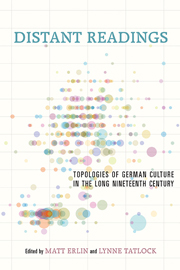Book contents
- Frontmatter
- Contents
- Acknowledgments
- Introduction: “Distant Reading” and the Historiography of Nineteenth-Century German Literature
- I Quantification
- 1 Burrows's Delta and Its Use in German Literary History
- 2 The Location of Literary History: Topic Modeling, Network Analysis, and the German Novel, 1731–1864
- 3 How to Read 22,198 Journal Articles: Studying the History of German Studies with Topic Models
- 4 Serial Individuality: Eighteenth-Century Case Study Collections and Nineteenth-Century Archival Fiction
- 5 The Case for Close Reading after the Descriptive Turn
- II Circulation
- III Contextualization
- Selected Bibliography
- Contributors
- Index
5 - The Case for Close Reading after the Descriptive Turn
from I - Quantification
Published online by Cambridge University Press: 05 April 2014
- Frontmatter
- Contents
- Acknowledgments
- Introduction: “Distant Reading” and the Historiography of Nineteenth-Century German Literature
- I Quantification
- 1 Burrows's Delta and Its Use in German Literary History
- 2 The Location of Literary History: Topic Modeling, Network Analysis, and the German Novel, 1731–1864
- 3 How to Read 22,198 Journal Articles: Studying the History of German Studies with Topic Models
- 4 Serial Individuality: Eighteenth-Century Case Study Collections and Nineteenth-Century Archival Fiction
- 5 The Case for Close Reading after the Descriptive Turn
- II Circulation
- III Contextualization
- Selected Bibliography
- Contributors
- Index
Summary
In a frequently cited article published in 2000, Franco Moretti envisions a future literary history that will step back from close readings of individual texts to gain a distant perspective on the system of literature in its entirety. “The United States is the country of close reading,” Moretti concedes, “so I don't expect this idea to be particularly popular.” He nevertheless proposes a new type of literary analysis whose innovative boldness will be “directly proportional to the distance from the text: the more ambitious the project, the greater must the distance be.”
Over the past decade Moretti has begun to realize his millennial vision, enlisting cadres of graduate students and his own formidable intelligence to produce literary histories that look very different from what has been done in the past—and I stress the visual difference of his work. In the place of prose narratives that describe major literary movements and towering individual geniuses, we find graphs, maps, and diagrams that one might expect to find in the work of statistically driven social scientists. And although Moretti may relish his role as a maverick among the herds of more traditional literary critics, his appeal for a more distant approach to literary systems has not gone unheeded. Stephan Best and Sharon Marcus have identified a recent movement toward “surface reading” in the work of critics who eschew the search for hidden meanings buried deep within the text in favor of a more neutral description of what lies in plain view. Heather Love has followed Bruno Latour around the “descriptive turn” to find a land beyond depth hermeneutics, where readings are close but not deep and the emotional landscape is flat and cold rather than rich and warm.
- Type
- Chapter
- Information
- Distant ReadingsTopologies of German Culture in the Long Nineteenth Century, pp. 133 - 152Publisher: Boydell & BrewerPrint publication year: 2014

